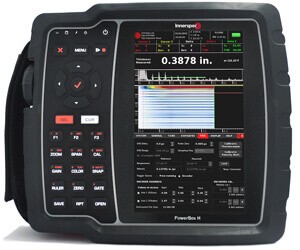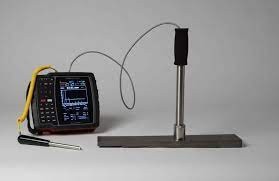EMAT transducers offer several advantages compared to the dual element piezoelectric transducers:
- it is not necessary to remove the oxide deposits (the oxide thickness is not added to the wall thickness measurement) and measurements can be performed very quickly without the use of coupling liquids;
- thickness measurement at high temperature (up to 750° C);
- insensitive to surface irregularities.
A magnetostrictive EMAT transducer consists of a powerful continuous-action magnet and a coil that function as an electromagnet when activated by an excitation pulse from the instrument. The continuous action magnet creates a magnetic field perpendicular to
the surface of the oxide deposit, while the dynamic field created by the electromagnet moves the oxide deposit radially outwards and inwards as a result of the coil being excited. This movement generates a transverse wave with a perpendicular incidence in the
oxide deposit which subsequently propagates in the steel.
Essentially, the deposit acts as an active element of the transducer to generate the sound impulse. The frequency of the sound pulse will vary according to the changes in the thickness of the oxide deposit, increasing as the thickness of the deposit decreases and decreasing as the thickness of the deposit increases. With typical thin oxide deposit thicknesses, the frequency will be approximately 5 MHz.
Since the oxide deposit itself represents the transducer element, the irregularity of the deposit does not represent any critical issue for the coupling.
EMAT transducer generates a transverse wave so that the instrument must be calibrated at a sound wave propagation speed of approximately 3.240 m/s typical of carbon steel.


